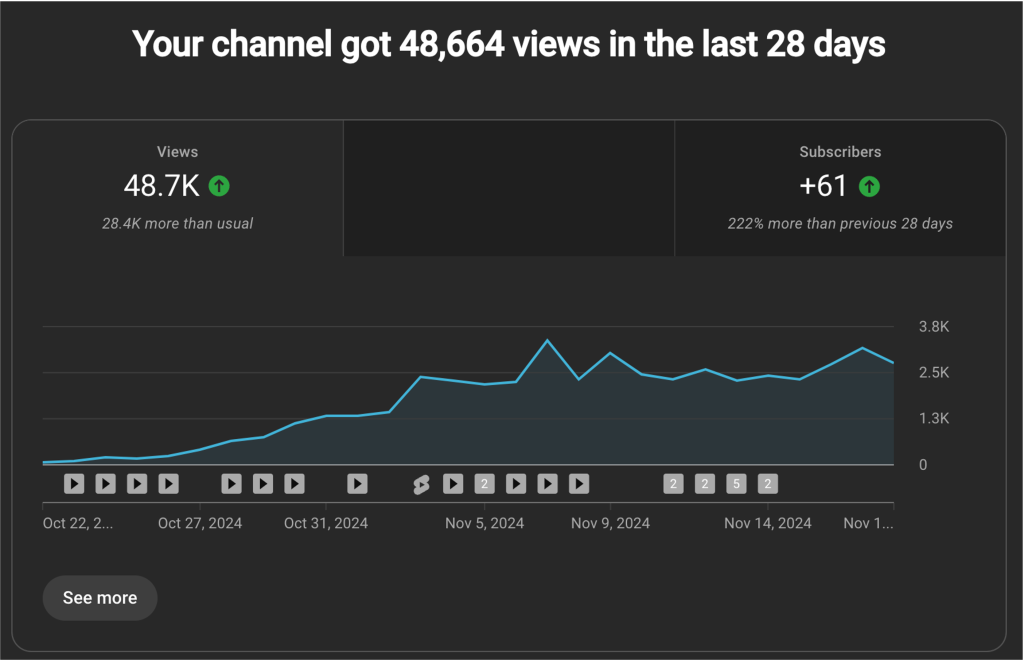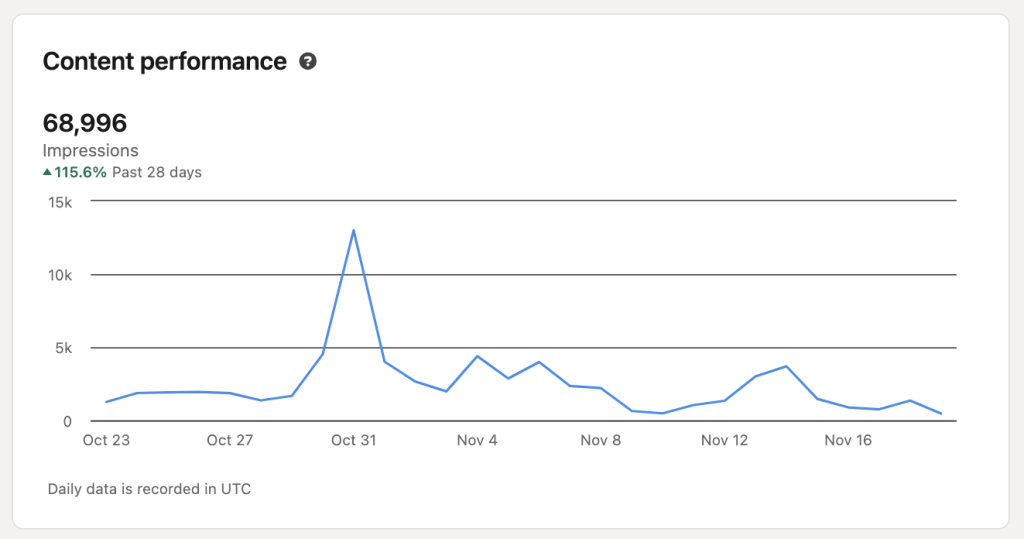This article shares some of the important and unique insights generated through TADSummit 2024. Insights you’ll not read anywhere else on where telecom innovation is going, and how voice AI is rapidly evolving and how to keep up.
Compare our numbers to other telecom events and organizations. TADSummit is the most viewed resource in Telecoms.
Over the past month we had close to 50k views of the videos on YouTube. On Linkedin close to 70k impressions, I use Linkedin to promote the weblog articles that include the videos.
The impressions peak on Linkedin around Oct 31st was mostly from ‘By The Numbers, The Honest CPaaS Review‘, ‘Wadaro, how in-SIM software is revolutionizing telecoms‘ and ‘Sponsor Keynote. The Rise and Rise of vCon, Thomas Howe.‘
Please remember the Mobile Ecosystem Forum chairman requests its members ignore my work, claiming it is a social media campaign. Its not, TADSummit is the truth, and MEF should be ashamed of itself.
Some of the popular TADSummit YouTube videos include (views as of Nov 19th):
- Wadaro, how in-SIM software is revolutionizing telecoms. Robert Wakeling, Founder & CEO. 5.7k youtube views
- Sponsor Keynote. The Rise and Rise of vCon, Thomas Howe. + SCITT and vCon AI governance for conversations, at scale. Steve Lasker. 4.3k youtube views
- By The Numbers, The Honest CPaaS Review 4k youtube views
- Programmable Global Carrier Digital Services, Sebastian Schumann, Deutsche Telekom 3.2k youtube views
- Evolve or Get Left Behind, The Next Generation of CPaaS is Here. Dinesh Saparamadu, hSenid Mobile 3k youtube views
Unique Insights
hSenid Mobile shows where telecom innovation is going.
In my opinion, hSenid Mobile created the most successful telco CPaaS. They made it easy for people, developers and business owners, to solve problems using telecoms. They raised telco revenues by 10-15%.
Back in 2012, when Ideamart launched on hSenid Mobile’s CPaaS, they had no code interfaces, just a webpage to use common templates, e.g. customer communications and alerting. With that and sustained country-wide engagement they created something quite unique, here a telco is at the heart of innovation across Sri Lanka and Bangladesh.
The new generation CPaaS is unified, omnichannel (I prefer multichannel), and complemented by AI (LLMs (Large Language Models) in particular). Breaking free of SMS is important, it’s still there, but WhatsApp has become the conversational channel in many markets. See all the WhatsApp hacks from TADHack Sri Lanka.
hSenid Mobile led some in the industry to success over one decade ago, e.g. IdeaMart. Others followed OneAPI to failure. I recommend following hSenid Mobile to success.
Evolve or Get Left Behind, The Next Generation of CPaaS is Here. Dinesh Saparamadu, hSenid Mobile
Voice AI, whatever you choose today, in 3 months it will have changed.
Using speech-to-speech models in conversational chatbots. Rob Pickering.
Rob’s conclusions are:
- Highly likely that multimedia approaches (speech-to-speech) will win out and deliver a much better experience long term.
- This will always be more expensive (but maybe not by so much) and offer less control than a discrete component pipeline approach.
- There is a chance of market capture when the AI provider has to build so much of the solution so maintaining a healthy ecosystem is going to be important.
- Rob will continue to build agnostic architectures. (That is not get trapped.)
Webio: Revolutionizing Debt Conversations with Conversation Intelligence. Paul Sweeney
Businesses need solutions, not lego sets. Webio delivers a measurable solution to resolving debt conversations using AI.
- Precision in context (understanding the situation and options)
- Data driven (using customer data to help resolve the issue)
- Compliance by design (I think vCon can help here)
- Seamless integration (a solution, not an IT project with lots of stitching)
- Measurable impact (understand the value Webio creates)
Build a solution that works and continuously evolve / develop as technology continues its rapid development.
Voice AI: Breaking Past the Bullshit. RJ Burnham, Founder & CEO at Consig AI.
Voice control to date has always been request response. Barge-in, and turn of conversation are all being worked out at the moment, As the interface moves to conversations and natural language, there are many uncertainties.
With OpenAI, voice and text are separate modes. They do not yet work together. And video will be added in time. Its early days. Also in speech mode, there are no guardrails, as the text rails are not applicable. New rails will need to be added.
RJ sees a more important challenge to be addressed, that is multi user mode across multiple people and agents.
It’s still early days, which is tough for large corporations to deliver in their existing platforms. Hence the strength smaller companies have in moving fast and delivering focused solutions.
Voxist’s Real Time Enterprise AI. Karel Bourgois.
Karel delivers an excellent review on the development of AI, its 70 years of evolution.
Voxist exists to put an end to the saying, “words fly away, writing remains”, in the enterprise. Within an enterprise only 10% of knowledge is explicit, the rest is implicit (tacit). That’s why getting up to speed in a job can take years. Given the retirement of baby boomers, tens of thousands to years of experience are being lost. This is one of the challenges Voxist are fixing.
Their platform, transforms conversations in the enterprise into AI powered business insights. Jokingly, Karel positions the platform as implementing vocal RAG (Retrieval-Augmented Generation), before RAG existed. Your own data is important, say you’re a baker, it’s your recipe for a chocolate cake that matters, not a generic recipe contained in the LLM.
With their platform Voxist has gathered all the explicit information in an enterprise, and using that to build questions to capture all the tacit knowledge. The challenge is we often don’t know what we know, until someone asks us a question. This enables Voxist to build a complete knowledge graph for an organization, that is specific to that enterprise. Hence the secret sauce remains safe within the organization, not harvested by a large tech company.
Vida Voice AI. Lyle Pratt, Vida.io Founder & CEO
Improvements coming soon are scraping your company’s website, vectorizing it, and making it available to the agent. So it the answer is not available from a prompt or RAG, or the website scrape, then transfer to a human. Currently with AI agents its a continuous evolution.
For 2025 developments include new outbound capabilities such as keeping CRM records up to date, sending outbound SMS reminders for scheduled events. With CRM integration, customers can be greeted by name, last interaction is available, also pipeline status if a deal is being discussed. Vida is expanding from inbound focused, to in and outbound.
Vida is a great example of using Voice AI in a focused way, and helping customers with the prompts to do what they need, as a small business is not a prompt engineer. Development is continuous, to not be left behind.
TADSummit Panel Discussion. Are LLMs about to disrupt enterprise SaaS (Software as a Service).
Innovators working in small companies can not survive on BS. TADSummit panel sessions always deliver the best insights.
- SaaS will evolve to include AI/LLMs
- LLMs are about to make enterprise SaaS even easier to setup and use.
- We’re entering a massive wave of automation through LLMs used in SaaS
- X does not replace Y, rather together we’re able to do more.
- AI models are going to change. We’re in a period of constant innovation, every month there’s something new. AI is a constant journey, not a product release, which is a challenge for the whole industry.
- Props to Mark Zuckerberg in open sourcing LLMs, which has changed the industry. We can avoid OpenAI ruling over industries and not worry about them going bust.
- Control/rational and orchestration will get wrapped up into LLMs, it’s going to get even easier.
- There’s no point specializing in being a technology platform as the technology is developing too fast, and we’re only a couple of years into it. Except where you can take advantage of language issues and local politics, e.g. in France.
More insights coming soon.



One thought on “TADSummit’s Insights Part 1”
Comments are closed.